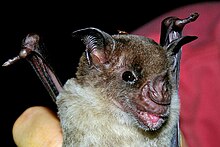Pale spear-nosed bat
| Pale spear-nosed bat | |
|---|---|
 |
|
| Scientific classification | |
| Kingdom: | Animalia |
| Phylum: | Chordata |
| Class: | Mammalia |
| Order: | Chiroptera |
| Family: | Phyllostomidae |
| Genus: | Phyllostomus |
| Species: | P. discolor |
| Binomial name | |
|
Phyllostomus discolor Wagner, 1843 |
|
 |
|
| Pale spear-nosed bat range | |
The pale spear-nosed bat (Phyllostomus discolor) is a species of phyllostomid bat from South and Central America.
Pale spear-nosed bats are relatively robust for bats. Adults range from 8 to 11 centimetres (3.1 to 4.3 in) in total length, with an average wingspan of 42 centimetres (17 in). Males are significantly larger than females, weighing an average of 45 grams (1.6 oz), compared with 40 grams (1.4 oz). The fur is variable in colour, and may range from a pale yellowish brown to a much darker, almost blackish shade, over most of the body. The chest and belly are much paler, varying from near white to frosted grey.
The wings are large, with rounded tips, and have an average aspect ratio of 7.13 and a wing loading of 13.6 pascals (0.00197 psi). The uropatagium is large, extending to the ankles, and is about three times the length of the tail, the tip of which projects from the upper surface of the membrane. The face is broad, with a short snout and rounded cranium, which encloses a large brain with well-developed cerebral hemispheres. The nose-leaf is well developed, with a long and broad spear-like projection from the upper surface, while the ears are also broad, and long enough to reach the tip of the snout when projected forward. Males have a large, glandular sac in the throat region, which is almost entirely absent in females.
The species ranges from southern Mexico to northern Peru, Bolivia, and Paraguay, and across to southeastern Brazil. Reports of its occurrence in northernmost Argentina are controversial, being based on only a single specimen, which was subsequently lost. It inhabits lowland forests and agricultural areas, at elevations up to 610 metres (2,000 ft). Two subspecies are currently recognised, although whether or not they are genuinely distinct has been questioned:
...
Wikipedia

